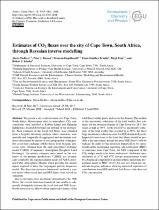 ResearchSpace
ResearchSpace
Estimates of CO2 fluxes over the City of Cape Town, South Africa, through Bayesian inverse modelling
JavaScript is disabled for your browser. Some features of this site may not work without it.
- ResearchSpace
- →
- Research Publications/Outputs
- →
- Journal Articles
- →
- View Item
| dc.contributor.author |
Nickless, A

|
|
| dc.contributor.author |
Rayner, PJ

|
|
| dc.contributor.author |
Engelbrecht, Francois A

|
|
| dc.contributor.author |
Brunke, E-G

|
|
| dc.contributor.author |
Erni, B

|
|
| dc.date.accessioned | 2018-05-21T08:51:19Z | |
| dc.date.available | 2018-05-21T08:51:19Z | |
| dc.date.issued | 2018-04 | |
| dc.identifier.citation | Nickless, A. et al. 2018. Estimates of CO2 fluxes over the City of Cape Town, South Africa, through Bayesian inverse modelling. Atmospheric Chemistry and Physics, vol. 18: 4765-4801 | en_US |
| dc.identifier.issn | 1680-7316 | |
| dc.identifier.uri | https://www.atmos-chem-phys.net/18/4765/2018/acp-18-4765-2018.pdf | |
| dc.identifier.uri | https://doi.org/10.5194/acp-18-4765-2018 | |
| dc.identifier.uri | http://hdl.handle.net/10204/10222 | |
| dc.description | © Author(s) 2018. This work is distributed under the Creative Commons Attribution 4.0 license. | en_US |
| dc.description.abstract | The results of a high resolution Bayesian inversion over the City of Cape Town, South Africa, are presented, which used observations of atmospheric carbon dioxide from sites at Robben Island and Hangklip lighthouses collected over a sixteen month period from March 2012 until June 2013. A Lagrangian particle dispersion model driven by the regional climate model Conformal Cubic Atmospheric Model (CCAM) was used to provide the sensitivities of the observations to the surface sources and boundary concentrations. This regional climate model was dynamically coupled to the CABLE (Community Atmosphere Biosphere Land Exchange) model, which provided prior estimates of the biogenic fluxes. Prior estimates of the fossil fuel emissions were obtained from an inventory analysis specifically carried out for this inversion exercise, making use of vehicle count data, population census data, fuel usage at industrial point sources, and aviation and shipping vessel counts. The inversion solved for the actual concentration measurements at each site, which was made possible by the use of the Cape Point background site to provide information on the boundaries, and was necessary due to the effect of topography on the atmospheric transport, affecting particularly the sensitivity of the Robben Island site to the surface fluxes. Night-time observations were included, but allocated much larger errors compared to the daytime observations. | en_US |
| dc.language.iso | en | en_US |
| dc.publisher | COPERNICUS GESELLSCHAFT MBH | en_US |
| dc.relation.ispartofseries | Worklist;20311 | |
| dc.subject | Bayesian inverse modelling | en_US |
| dc.subject | City of Cape Town CO2 fluxes | en_US |
| dc.title | Estimates of CO2 fluxes over the City of Cape Town, South Africa, through Bayesian inverse modelling | en_US |
| dc.type | Article | en_US |
| dc.identifier.apacitation | Nickless, A., Rayner, P., Engelbrecht, F. A., Brunke, E., & Erni, B. (2018). Estimates of CO2 fluxes over the City of Cape Town, South Africa, through Bayesian inverse modelling. http://hdl.handle.net/10204/10222 | en_ZA |
| dc.identifier.chicagocitation | Nickless, A, PJ Rayner, Francois A Engelbrecht, E-G Brunke, and B Erni "Estimates of CO2 fluxes over the City of Cape Town, South Africa, through Bayesian inverse modelling." (2018) http://hdl.handle.net/10204/10222 | en_ZA |
| dc.identifier.vancouvercitation | Nickless A, Rayner P, Engelbrecht FA, Brunke E, Erni B. Estimates of CO2 fluxes over the City of Cape Town, South Africa, through Bayesian inverse modelling. 2018; http://hdl.handle.net/10204/10222. | en_ZA |
| dc.identifier.ris | TY - Article AU - Nickless, A AU - Rayner, PJ AU - Engelbrecht, Francois A AU - Brunke, E-G AU - Erni, B AB - The results of a high resolution Bayesian inversion over the City of Cape Town, South Africa, are presented, which used observations of atmospheric carbon dioxide from sites at Robben Island and Hangklip lighthouses collected over a sixteen month period from March 2012 until June 2013. A Lagrangian particle dispersion model driven by the regional climate model Conformal Cubic Atmospheric Model (CCAM) was used to provide the sensitivities of the observations to the surface sources and boundary concentrations. This regional climate model was dynamically coupled to the CABLE (Community Atmosphere Biosphere Land Exchange) model, which provided prior estimates of the biogenic fluxes. Prior estimates of the fossil fuel emissions were obtained from an inventory analysis specifically carried out for this inversion exercise, making use of vehicle count data, population census data, fuel usage at industrial point sources, and aviation and shipping vessel counts. The inversion solved for the actual concentration measurements at each site, which was made possible by the use of the Cape Point background site to provide information on the boundaries, and was necessary due to the effect of topography on the atmospheric transport, affecting particularly the sensitivity of the Robben Island site to the surface fluxes. Night-time observations were included, but allocated much larger errors compared to the daytime observations. DA - 2018-04 DB - ResearchSpace DP - CSIR KW - Bayesian inverse modelling KW - City of Cape Town CO2 fluxes LK - https://researchspace.csir.co.za PY - 2018 SM - 1680-7316 T1 - Estimates of CO2 fluxes over the City of Cape Town, South Africa, through Bayesian inverse modelling TI - Estimates of CO2 fluxes over the City of Cape Town, South Africa, through Bayesian inverse modelling UR - http://hdl.handle.net/10204/10222 ER - | en_ZA |





